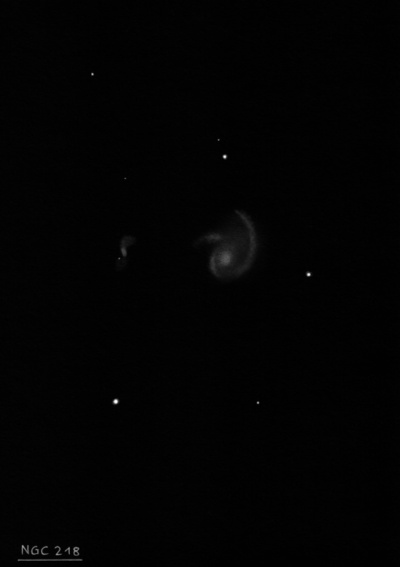
Édouard Stephan discovered NGC 218 = St VIIIa-3 on 17 Oct 1876 with the 31" reflector at the Marseille Observatory. His published position implies an offset of just 40" S of mag 8.9 SAO 54096 (given as the offset star) but there is nothing at this position and his description makes no mention of a nearby bright star. The only nearby candidate is UGC 440, which is located 45 tsec W and almost 2' N of Stephan's offsets, and this galaxy is taken as NGC 218 in all modern catalogues.
I checked Emmanuel Esmiol's 1916 re-reduction of Stephan's positions at Marseilles Observatory and found that NGC 218 was left off of the main tables, but replaced with an "Anonymous" galaxy using a different delta RA but the same offset star (SAO 54096) and the same delta Dec. Esmiol's new position corresponds exactly with UGC 480, although apparently this correction to the position of NGC 218 has gone unnoticed until now. At the bottom of the page is the note "wrongly identified as NGC 218". So, NGC 218 = UGC 480. Harold Corwin and Wolfgang Steinicke agree with this analysis. Wolfgang notes in his book on the history of the NGC, that Esmiol's catalogue gives 4 discoveries of Stephan that did not receive NGC designations, but he missed this connection with NGC 218. This identification has now been incorporated into NED, although it is still incorrect in HyperLeda (as of 2013) as well as the NGC/IC Project, which has not been updated in a long time.
400/500mm - 17.5" (9/1/02): fairly faint, fairly small, irregular shape and surface brightness, 1.0' diameter, broadly concentrated. Forms the right angle of a small isosceles triangle with two mag 13.5-14 stars 1.4' N and 1.3' W. Forms an interacting pair with MCG +06-02-017 1.4' E. The companion is very faint, small, elongated 2:1 N-S, 0.5'x0.25'. Member of the Pisces-Perseus Supercluster.
600/800mm - 24" (12/22/14): moderately bright and large, irregularly round, ~0.8' diameter though the halo increases in size and shape with averted vision. A brighter nucleus is offset to the east side of the galaxy, so could be mistaken for a knot in the halo. Forms an interacting pair with CGCG 519-022 1.4' ENE.
CGCG 519-022 is fairly faint, fairly small, slightly elongated N-S, 0.4'x0.2', very weak concentration. The SDSS reveals numerous thin, blue arm segments of NGC 218 that are apparently tidally stretched towards CGCG 519-022.
Notes by Steve Gottlieb